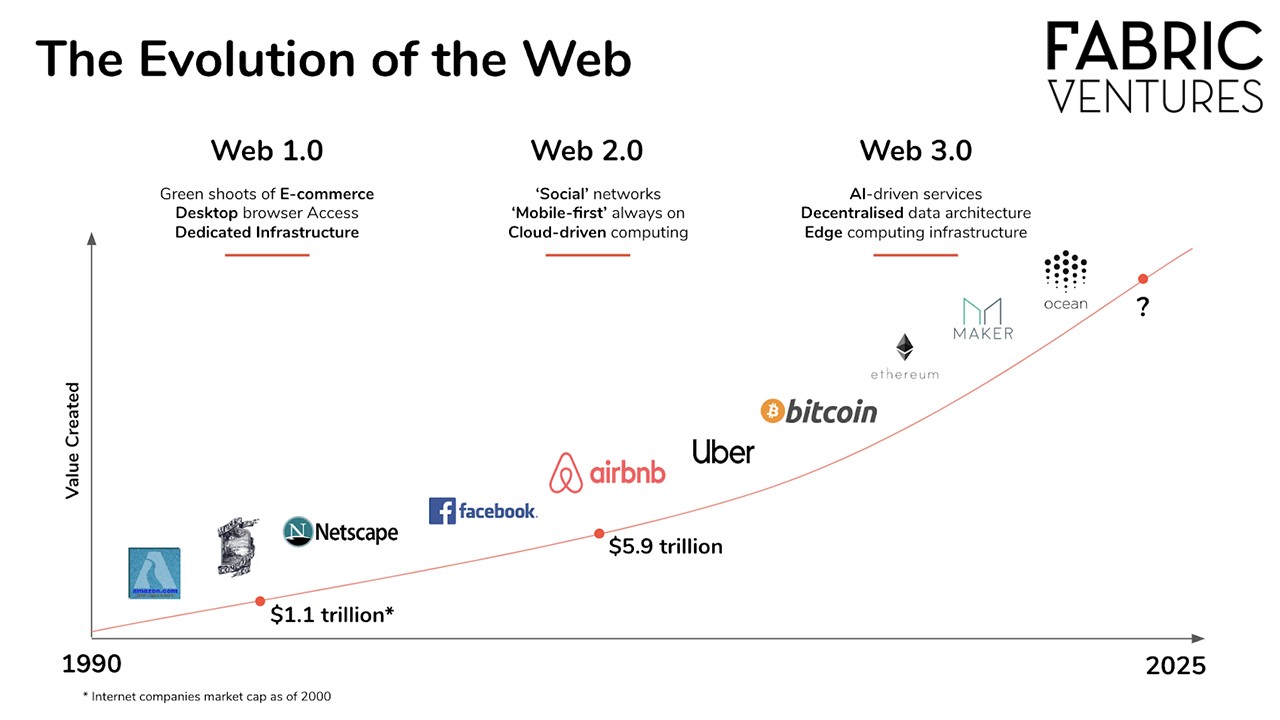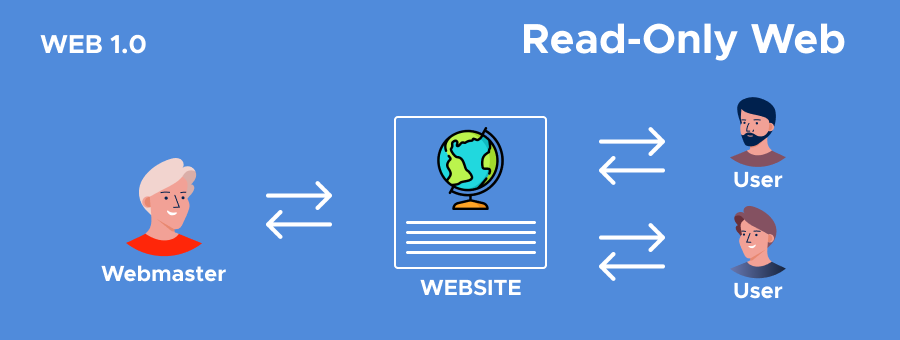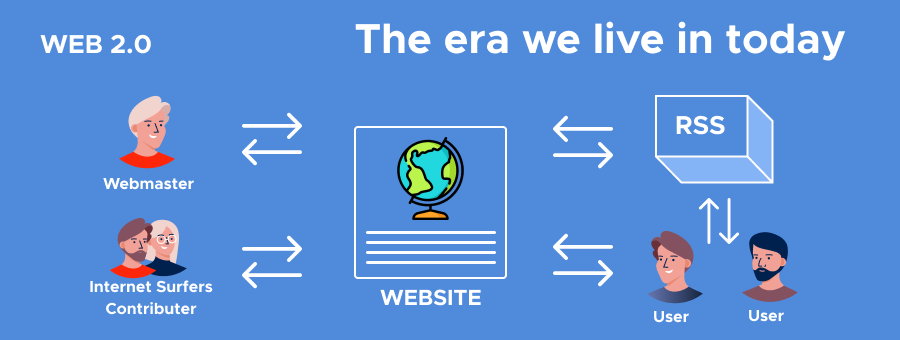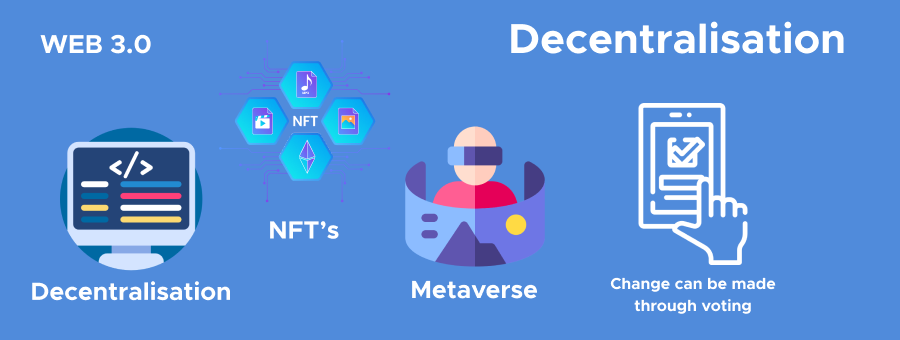Table of Contents
Every modern person notices how the Internet is rapidly developing. New technologies and innovative developments are emerging that have a huge impact on the development of not only our society but all mankind. The modern Internet has come a long and difficult way in its development to provide us with almost unlimited access to a vast amount of unique data. The Internet has evolved and, in almost 50 years, has gone from Web 1.0 to Web 3.0. Let’s examine these stages of development by studying the features of Web 1.0, Web 2.0, and Web 3.0 and talk about the future of programmatic advertising.

Web 1.0 [Read only]
It is noteworthy that the definition of Web 1.0 appeared after the advent of Web 2.0 because users noticed significant changes after the first “version”. This phase of the network’s iteration lasted for a relatively long period, from 1991 to 2004. At that time, users could only view pages, so this version is called Read Only. People did not yet have the opportunity to interact with Internet content or take part in its creation. In other words, users only consumed what was on the virtual pages. It is also important to note that at that time, there were no trackers, registrations, accounts, or authorizations. The design of the sites was quite primitive compared to the modern variety and interactivity. Most online platforms provided users with “raw” text, neglecting HTML markup.

Digital advertising was not very popular; it was hyperlinked in the text, and later banners appeared. Some websites added GIF animations, bright colors, and textures to give the page some life. Toward the end of the Web 1.0 era, people saw chat rooms and forums, so they could participate in the creation of Internet content. However, even such a well-known online store as Amazon only allowed people to leave reviews from the very beginning.
Web 2.0 [Participative Web]
At this stage, the Internet had already begun to appreciate user-generated content, and the use of sites had become more convenient, with interoperability appearing. The technical features of online pages and design methods also improved. Blogs, social networks, podcasts, and RSS emerged. Web browser technologies also evolved, with AJAX and JavaScript frameworks being used. The era of GIF animation passed, and more complex animations appeared. Companies began to open their virtual portals, making them adaptive (that is, with the ability to open on both desktops and smartphones).

But, in addition to free access to a vast amount of information, more virtual threats appeared. Many sites began to contain advertising; these were bookmarks of the promoted site and an offer for users to add this or that page to their bookmarks. Another great advertising implementation is Q&A services. It was already something similar to the modern Web with lots of banners, videos, and other advertising formats. In the 2010s, the successful development of programmatic advertising began, which helped to promote thousands of large and small companies. However, the further development of technology and the advertising industry has resulted in negative effects on ordinary web users. Digital corporations have begun to track huge amounts of data about people and aggressively use it for advertising purposes. This has outraged a vast number of people who would like to see the Internet more open, decentralized, and private.
Web 2.0 started in 2004 and is still ongoing. We are now living in a period of transition to Web 3.0, which promises to turn the above values into reality
Web 3.0 [Read-Write-Execute]
This version is considered the future of the Internet because it has created a space with decentralized platforms. This era includes a more intelligent and autonomous Internet where all data is connected conceptually. Users will be able to interact in a more decentralized way but with greater security. Protecting money, information, payments, and personal data is an advantageous condition for companies, ordinary users, big corporations, and banks.

To better understand the picture, let’s define the main characteristics of Web 3.0:
- Intelligent algorithms have not left the Internet; they continue to help users find the information they need.
- Almost all computing processes are transferred from data centers to various “smart” gadgets of people.
- There will be more advertising because companies are transferring the sale of their products to virtual spaces. It is possible to purchase almost anything and find any service.
The software gets open source to see how the tools work and how they interact with site visitors. - More opportunities for blockchain, crypto investors, and NFT enthusiasts. Here it is interesting to mention that from 2021 to 2022, games based on the blockchain increased by 2000%.
The new wave of Web 3.0 is an opportunity to build a global village – a universe that will be focused on people and interpersonal interaction. This will contribute to the development of not only business but also technology. The new era is a good environment for promoting private initiatives, such as start-ups. The possibilities of this generation of the Internet are impressive, but some experts say that all experiments with new implementations depend only on investment.
Web 3.0 and the Future of Programmatic Advertising
The virtual world impresses with its versatility and the possibility of implementing almost any idea. Some experts criticize the new generation of the Internet because they see an exclusive focus on money relations. But more opportunities for companies mean more sales and more profits. The era of Web 3.0 provides more possibilities not only for earning but also for education, science, history, and other areas. Many companies will become Decentralized Autonomous Organizations where vital issues are decided not by the director but by the participants of the DAO. This is more profitable for the company because the participants discuss the product, advertise it and decide what needs to be fixed or changed to make the product more popular.
Also, Web 3.0 is a real heaven for programmatic advertising because there is no real-world factor here. In this era, new technologies are developing that allow for improving advertising tools, placements, and formats. Not everything in the real world can be effective for advertising, and the metaverse will become a cutting-edge approach. For example, the development of cookieless technologies makes it possible to achieve greater anonymization. Open-source software allows you to accelerate the development of new advertising technologies. NFT and crypto leads to completely new ways to interact with the ad viewer.
Summary
We have studied how the World Wide Web has evolved over the past decades and how Digital Advertising is connected to this growth. Technology is developed for different fields of activity to help people, and in the future, we are waiting for global changes. Despite the evolving possibilities of Web 3.0, we are in for a revolutionary breakthrough with the gradual introduction of the Web 4.0 era. And, most likely, here we will already discuss not just the relationship between a person and a computer, but the relationship between a person and a robot running on AI. Imagine that in 20 years the target audience for your start-up business will be an AI living in the metaverse. Your ads are shown by devices connected to humans, and you receive anonymous user data using a technology similar to blockchain. There are many things to consider…
And if you want to build an impactful digital campaign, contact us and we will serve you with the best solution!

